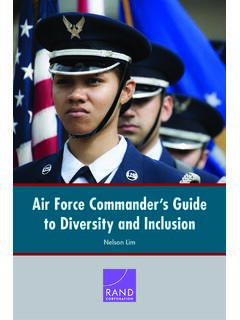Transcription of FINDING THEMES - SAGE Publications Inc
1 53C H A P T E R3FI NDINGTHEMESA uthors note:Werelyheavilyin thischapteronourarticleRyanandBernard,Fi eldMethods15(1):85 20 03 sage s a Theme?Where Do ThemesCom e From?Eight ObservationalTec hn iques:Thi ngs toLook For1. Re petitions2. In digenousTypol ogies or Cat ego ries3. Metaphorsand Analogies4. Transitions5. Simi la ritiesand Differences6. Li nguisticConnectors7. Miss in g Data8. Theory-Rela ted Mat er ialFour Manipulative Techniques: WaystoProcessTexts9. Cuttingand So rt ing10. WordLis ts and Key -Words-in-Context (KWIC)11. WordCo-o ccu rre nc e12. Me tacodingSelecting AmongTechniques1. Kindof Dat a2. Skill3. La bor4. Nu mberand Kindsof The mes5. Rel iabilityand ValidityAnd INTRODUCTIONA nalyzingtextinvolvesfi vecomplextasks: (1)discoveringthemesandsubthemes; (2)describingthecore andperipheralelementsofthemes;(3)buildin ghierarchies ofthemesorcodebooks;(4)applyingthemes thatis,attachingthemto chunksofactualtext;and(5)linkingthemesin toth ,wefo cusonthefirstta sk : discoveringth emes andsubthemes.
2 Then,inChapter4,wediscussmethodsfordescr ibing th emes,buildingcodebooks,andapplyingthemes to buildi fo r discovering themescomefromacrossth e canbedonebyacomputer tolabor-intensive,line-by-lineanalysesth at,sofar,onlypeopleca chniquehas ll see, somemethodsarebetterforanalyzinglong,com ple x narratives,andothersarebetterforshortres pons estoopen-ended quiremorelabor andskill, ll havemoretosayla te r about howyouchooseamongthesemethods . WHAT SA THEME?This questionhasa longhistory. Thompson(1932 36)createdanindex offolktalemotifs, orthemes, ,MorrisOpler,ananthropologist, madeth e id entif icationofthemesa keyst :Ineveryculturearefounda limitednumber ofdynamicaffirmations,calledth emes, whichcontrolbehaviororstimulateactivity. Theactivities,prohibitionsofactivities,o rreferenceswhichresultfromth e acceptanceofa themear ofa theme, ofcourse,aidusin discoveringit.
3 ( 199)Oplerestablishedthreeprinciplesforan alyzing th ,heobservedth atthemesareonlyvisible (andthusdiscovera ble) , ,Oplernoted that so meexpres-sionsofa themeareobviousandcultu rallyagreedon,butothersaresubtler,symbol ic , PARTITHEBASICSA ndth ird,Opler observedthatculturalsystemscomprisese , hesaid,isrelatedto:(1 ) howoftenit appears;(2 ) howpervasiveit is acrossdifferent types ofcult uralideasandpractices;(3 ) howpeoplereactwhenth ethemeisviolated;and(4 ) thedegreetowhichth e forceandva riety ofa th eme sexpressionis controlledbyspecificcontext s ( ).Chapter3 FindingThemes 55 Termsfo r ThemesToday,socialscientistsstill talk abo ut the linkage betweenthe mes and the irexpressions, but use differenttermsto do so. Gr oundedtheoriststa lk about categories (Glaserand A. Strauss1967), codes (Milesand Huberman 1994),or l abel s (De y 1993:96).
4 Opler s exp ressions are called inc ide nts (Glaserand A. Strauss 1967), segmen ts (Tesch1990), thematic units (Krippendorff1980b), d ata- bits (D ey 1993),and chunks (Milesand Huberman1994).Linco ln and Gu ba referto exp ressionsas units (1985:345).A. Str aussandCorbin(199 0:6 1) ca ll them con cepts tha t are groupedtog etherin a higherord er of classification to , we fo llow Ag ar s lead(1979,1980a)and remainfa ithfulto Ople r sterminology. To us, the terms theme an d expression morenaturallyconnotethe fundamenta l co nceptswe ar e tyingto describe. In everydaylanguage, wetal k aboutth em es thatap pearin tex ts, pa intings,and moviesand ref er toparticular instances as expressions of go odnessor ange r or evil. In selectingone set of term s over others,we surelyignoresubtledifferences, but the basicideasare just as useful Themescomebothfromdata(aninductiveapproa ch)andfromourpriortheoreticalunderstandi ngofwhateverphenomenonwearestudying (anapriori,ordeductiveapproach).
5 A priorithemescomefromchara cteristicsofthephenomenabeingstudied whatAristotleidentifiedasessences andwhatdozensofgenerationsofscholarssinc ehavereliedonasa youarest udying th e night sky,forexample,it won t takelongtodecidethatthere is a unique,largebody(th e moon), afewsmall bodiesthatdon ttwinkle(p la nets) , and millions ofsmallbodiesthatdotwinkle (s tars).Apriorithemesalsocomefromalready-a greed-onprofessionaldefinitionsfoundinli teraturereviews;fromlocal,commonse nseconstructs;andfromresearchers values,theoreticalorientations,andperson alexperiences(Bulmer1979;Maxwell2005; ). (1 990:4 1 47)calltheuseofa priorith howbesttoquerypeopleaboutth os e topicsarerich sourcesofa priorithemes(Dey 1993:98). Infa ct,th e firstpass atgeneratingthemesoftencomes fromthequest ions inaninterviewprotocol(CoffeyandAtkinson1 996:34).
6 Mostly,though,th emesarederivedempirically witha fixedsetofopen-endedquestions, th ere s nowaytoanticipateallthethemesthatwi ll comeupbeforeyouanalyzea setoftexts(Dey1993:97 9 8). Theactofdi scoveringthemes is whatgrounded theoristscallopencoding,andwhatclassicco ntentanalystsca llqualitativeanalysis(Berelson195 2)orlatentcoding(ShapiroandMarkoff1997). Therearemanyvariationsonthesemethodsandm any recipes forarriving ata pr eli minarysetofthemes(Tesch1990:91). We ll describeeightobser vationaltechniques thingstolookforintexts andfourmanipulativetechniques ways (Furt herReading:findingthemes.) EIGHTOBSERVATIONALTECHNIQUES: THINGSTOLOOK FORL ookingforthemesin writtenmaterialtypicallyinvolvespawingth roughtextsandmarkingthemupwithdifferent in te r-vi ews,theprocess ofidentifyingthemesbegins video,audio,or writtendocuments,handlingthemphysically is alwayshelpfulforfindin g th whattolookfo Anyonewhohaslistenedtolongstretchesofta lk, saysD Andrade, knowshowfr equentlypeopl e circle throughth e samenet workof ideas (1991:287).
7 Repetitioniseasytorecogniz e inte xt . ClaudiaStrauss (1992)didseveralin-depthinterviewswith Tony,a retiredbl ue-collarworker andagaintoideasassociatedwit h greed,56 PARTITHEBASICS money, businessmen,siblings,and beingdifferent. Straussconcludedth attheseideaswere importantthemesinTony s id eaofhowtheseideaswererelated,Strausswrot ethemona pieceofpaper andconnectedthemwithlinestosnippetsofTon y s verbatimexpressions muchasresearcherstodaydowithtextanalysis so text, onsmakeanimportantth eme, however, ndthemesis tolookforunfamiliar,local words,andforfa miliarwordsthatareused inunfamiliarways what Pa ttoncalls indi-genous cat egories (2002:454; andseeLinnekin1987).Groundedtheoristsref ertothepr ocessofidentifying localtermsas invivocoding( ra uss1987:28; andCorbin1990:61 74).Ethnographerscallthisth esearchfortypologiesorclassificationsche mes (BogdanandTaylor1975:83)orcult uraldomains(Spradley1979:1 07 119).
8 Ina classic ethnographicstudy,Spradley(1972)recorded conversationsamongtrampsatinformalgather ings,meals,and lkedto eachotherabouttheirexperiences,theyke ptmentionin g theideaof makinga flop, which tu rnedout tobethelo caltermforfi ndinga throughhis recorded material andhisfieldnotesforstatementsabout makinga flopandfo undthat he couldcategorize themintosubthemessuchaskindsofflops, waystomakeflops ,waystomakeyourownflop, kindsof people whobotheryouwhenyouflop,waystomakea bed,andkindsofbeds. Spra dleyreturn edtohisinformantsandaskedformoreinformat ionabouteachofthesu bt ex amplesofcodingforin digenouscategories seeBecker s (1993 ) descriptionofmedicalstudents useoftheword cr ock andAgar s (1973)descriptionofdrugaddicts understandingsofwhatit meansto sh oot up. , Lakoff andJohnson(20 03[1980]) observedthatpeopleoftenrepresenttheirtho ughts,behaviors, an dexperiences withmetaphors ,th en,becomesthesearchformetaphorsinrh et oricanddeducingthesc hemas,orbroad, underlying themesthatmightproducethosemetaphors(D Andrade1995; ).
9 Chapter3 FindingThemes 57 NaomiQuinn(1996)analyzedover300hoursofin terviewsfrom11 Americancouplestodiscoverthemesinth e wayAmericanstalkaboutmarriage . Shefoundth atwhenpeopl e weresu rp ris ed that somecouple hadbr okenup,theysaidtheythoughtthecouple s marriagewas liketh e RockofGibraltar orthatthemarriagehadbeen nailedince ment. Peopleuseth es e metaphors,saysQuinn,becausethey knowth attheirlisteners(p eoplefromthesameculture)understandthatce mentandtheRockofGibraltarareth (1983)examinedtr anscr iptsofargumentspre sentedbyindependenttruckersatpublicheari ngsoftheIn terstate CommerceCommissiononwhethertodi scontinuea fuelsur that allcostshadrisendramaticallyintheprecedi ngcoupleofye arsandlikenedthesurchargetoputtinga bandageona patie ntwho hadin ternal ,hesai d,thefu elsurchargewas the liferaft th attruckersclungtoforsu rvival(Agar1983:603).
10 Naturalhumanspeechis 14, ,newparagraphsmayin dicateshifts eech,pauses,changesintoneofvoice,or thepresenceofpart icula r ,investigatorssteerth e conversationfromonetopictoanother,creati ngtr ansitions,whereas intwo-party andmulti-partynaturalspeech,transitionso ccurcontinuall s ofconversationexaminefeaturessuchasturnt akingand speakerinterruptionstoidentifyth es e Chapter (1967:101 116)labeledth e constantcomparisonmethod involvessearchingforsimilaritiesand differences bymakingsy stematic comparisonsacrossunitsofdata. Typically,groundedth eoristsbeginwi tha line-by-lineanalysis,asking: Whatisth issentenceabout? and Howis it similarordifferentfromtheprecedingorfoll owingstatements? Thiskeepstheresearcherfocusedonthedatara therthanonth eoreticalfl ightsoffancy(Charmaz1990,2000;Glaser1978 :56 72; 90:84 95). Lookatthefo llowin g exchange:58 PARTITHEBASICSI nterviewer:So,whatcanpeople do tohelptheenvironment?















